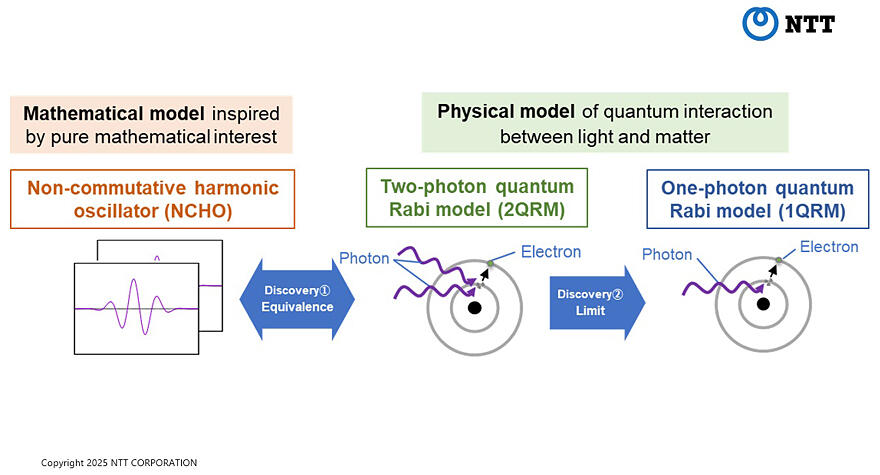NTT has elucidated the connection between research models that were previously studied independently in basic mathematics and physics (quantum optics). Specifically, they clarified the relationship between the mathematical model of a "non-commutative harmonic oscillator" and the physical model of a "quantum Rabi model." The physical model serves as the basic component for quantum computers using superconductivity. NTT believes that further development of this discovery on both theoretical and experimental fronts could contribute to the practical application of quantum computers.
Moving forward, NTT aims to make further discoveries by linking theory and experiments, such as realizing theoretically proposed computation methods through actual machines. NTT exhibited and introduced this research achievement at the NTT Communication Science Laboratories Open House 2025, which started on May 20.

Provided by NTT
The NTT Institute for Fundamental Mathematics, established in October 2021, has been studying the quantum Rabi model (QRM) from a basic mathematics perspective as part of its research. QRM is a fundamental model in quantum optics describing light-matter interaction, particularly serving as a model for basic components of quantum computers using superconductivity. Theoretical solution calculation methods have been found for this model, and their correctness has been experimentally verified.
On the other hand, the non-commutative harmonic oscillator (NCHO) is a mathematical model that was introduced in 2002 purely out of mathematical curiosity. It is an extension of the quantum harmonic oscillator, which is considered a model of electromagnetic fields, introduced to discover a richer mathematical structure compared to previously conceived theories. Indeed, interesting mathematical (number theory) phenomena have been found from NCHO.
Although QRM and NCHO were initially introduced for different purposes, prior research discovered that taking a certain limit of NCHO yields the (single-photon) QRM, thus uncovering the connection between the two models.
However, the previous research did not explicitly provide how the parameters of NCHO and (single-photon) QRM correspond before and after taking a limit, and thus the theory was not yet sufficient to apply to predicting specific phenomena. Moreover, while researchers had pointed out various physical similarities of NCHO, the essential correspondence to any physical model remained unresolved.
In response, NTT made two key discoveries. The first was finding that the mathematical model NCHO is mathematically equivalent to the two-photon quantum QRM physical model in terms of eigenvalue problems.
The two-photon QRM is a physical model describing how matter simultaneously interacts with two photons. This discovery clarified for the first time that the previously unidentified physical model corresponding to NCHO is the two-photon QRM.
The second discovery was describing, with unprecedented clarity, how taking a limit of two-photon QRM yields the single-photon QRM. This outcome further refines the relationship between NCHO and single-photon QRM found in previous research.
While previous research lacked clear parameter correspondence before and after taking a limit, NTT's research reframed this by examining the relationship between two-photon and single-photon QRMs, thereby explicitly clarifying the parameter correspondence.
These discoveries suggest that by leveraging the accumulation of such mathematical research, new and mathematically intriguing properties in quantum optics may be uncovered. In this sense, this finding not only deepens the connection between mathematics and physics but also blazes a trail for a unified understanding of different single-photon and two-photon models.
This article has been translated by JST with permission from The Science News Ltd. (https://sci-news.co.jp/). Unauthorized reproduction of the article and photographs is prohibited.




